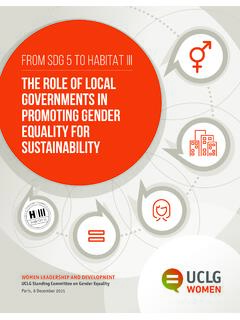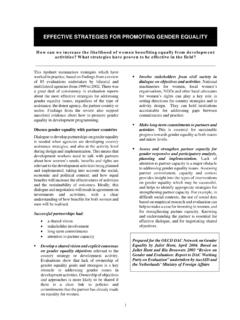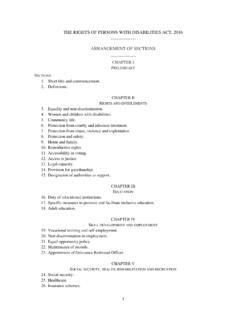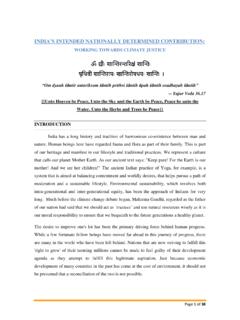Transcription of THE CONSTITUTION OF INDIA
1 THE CONSTITUTION OF INDIA . [As on 26th November, 2021]. PREFACE. This is the fifth pocket size edition of the CONSTITUTION of INDIA in the diglot form. In this edition, the text of the CONSTITUTION of INDIA has been brought up-to-date by incorporating therein all the amendments up to the CONSTITUTION (One Hundred and Fifth Amendment) Act, 2021. The foot notes below the text indicate the CONSTITUTION Amendment Acts by which such amendments have been made. The CONSTITUTION (One Hundredth Amendments) Act, 2015 containing details of acquired and transferred territories between the Governments of INDIA and Bangladesh has been provided in APPENDIX I. The CONSTITUTION (Application to Jammu and Kashmir) Order, 2019 and the declaration under article 370(3) of the CONSTITUTION have been provided respectively in Appendix II and Appendix III for reference.
2 New Delhi; Dr. Reeta Vasishta, Secretary to the Government of INDIA . 2. THE CONSTITUTION OF INDIA . _____. CONTENTS. _____. PREAMBLE. PART I. THE UNION AND ITS TERRITORY. ARTICLES. 1. Name and territory of the Union. 2. Admission or establishment of new States. [2A. Sikkim to be associated with the Union. Omitted.]. 3. Formation of new States and alteration of areas, boundaries or names of existing States. 4. Laws made under articles 2 and 3 to provide for the amendment of the First and the Fourth Schedules and supplemental, incidental and consequential matters. PART II. CITIZENSHIP. 5. Citizenship at the commencement of the CONSTITUTION . 6. Rights of citizenship of certain persons who have migrated to INDIA from Pakistan. 7. Rights of citizenship of certain migrants to Pakistan.
3 8. Rights of citizenship of certain persons of Indian origin residing outside INDIA . 3. 9. Persons voluntarily acquiring citizenship of a foreign State not to be citizens. 10. Continuance of the rights of citizenship. 11. Parliament to regulate the right of citizenship by law. PART III. FUNDAMENTAL RIGHTS. General 12. Definition. 13. Laws inconsistent with or in derogation of the fundamental rights. Right to equality 14. equality before law. 15. Prohibition of discrimination on grounds of religion, race, caste, sex or place of birth. 16. equality of opportunity in matters of public employment. 17. Abolition of Untouchability. 18. Abolition of titles. Right to Freedom 19. Protection of certain rights regarding freedom of speech, etc. 20. Protection in respect of conviction for offences.
4 21. Protection of life and personal liberty. 21A. Right to education. 22. Protection against arrest and detention in certain cases. Right against Exploitation 23. Prohibition of traffic in human beings and forced labour. 24. Prohibition of employment of children in factories, etc. Right to Freedom of Religion 25. Freedom of conscience and free profession, practice and propagation of religion. 26. Freedom to manage religious affairs. 27. Freedom as to payment of taxes for promotion of any particular religion. 28. Freedom as to attendance at religious instruction or religious worship in certain educational institutions. 4. Cultural and Educational Rights 29. Protection of interests of minorities. 30. Right of minorities to establish and administer educational institutions.
5 [31. Compulsory acquisition of property. Omitted.]. Saving of Certain Laws 31A. Saving of Laws providing for acquisition of estates, etc. 31B. Validation of certain Acts and Regulations. 31C. Saving of laws giving effect to certain directive principles. [31D. Saving of laws in respect of anti-national activities. Omitted.]. Right to Constitutional Remedies 32. Remedies for enforcement of rights conferred by this Part. [32A. Constitutional validity of State laws not to be considered in proceedings under article 32. Omitted.]. 33. Power of Parliament to modify the rights conferred by this Part in their application to Forces, etc. 34. Restriction on rights conferred by this Part while martial law is in force in any area. 35. Legislation to give effect to the provisions of this Part.
6 PART IV. DIRECTIVE PRINCIPLES OF STATE POLICY. 36. Definition. 37. Application of the principles contained in this Part. State to secure a social order for the promotion of welfare of the 38. people. 39. Certain principles of policy to be followed by the State. 39A. Equal justice and free legal aid. 5. 40. Organisation of village panchayats. 41. Right to work, to education and to public assistance in certain cases. Provision for just and humane conditions of work and maternity 42. relief. 43. Living wage, etc., for workers. 43A. Participation of workers in management of Industries. 43B. Promotion of co-operative societies. 44. Uniform civil code for the citizens. 45. Provision for early childhood care and education to children below the age of six years.
7 46. Promotion of educational and economic interests of Scheduled Castes, Scheduled Tribes and other weaker sections. 47. Duty of the State to raise the level of nutrition and the standard of living and to improve public health. 48. Organisation of agriculture and animal husbandry. 48A. Protection and improvement of environment and safeguarding of forests and wild life. 49. Protection of monuments and places and objects of national importance. 50. Separation of judiciary from executive. 51. Promotion of international peace and security. PART IVA. FUNDAMENTAL DUTIES. 51A. Fundamental duties. PART V. THE UNION. CHAPTER I. THE EXECUTIVE. The President and Vice-President 52. The President of INDIA . 53. Executive power of the Union. 54. Election of President.
8 6. 55. Manner of election of President. 56. Term of office of President. 57. Eligibility for re-election. 58. Qualifications for election as President. 59. Conditions of President's office. 60. Oath or affirmation by the President. 61. Procedure for impeachment of the President. 62. Time of holding election to fill vacancy in the office of President and the term of office of person elected to fill casual vacancy. 63. The Vice-President of INDIA . The Vice-President to be ex officio Chairman of the Council of 64. States. 65. The Vice-President to act as President or to discharge his functions during casual vacancies in the office, or during the absence, of President. 66. Election of Vice-President. 67. Term of office of Vice-President. 68. Time of holding election to fill vacancy in the office of Vice-President and the term of office of person elected to fill casual vacancy.
9 69. Oath or affirmation by the Vice-President. 70. Discharge of President's functions in other contingencies. 71. Matters relating to, or connected with, the election of a President or Vice-President. 72. Power of President to grant pardons, etc., and to suspend, remit or commute sentences in certain cases. 73. Extent of executive power of the Union. Council of Ministers 74. Council of Ministers to aid and advise President. 75. Other provisions as to Ministers. The Attorney-General for INDIA 76. Attorney-General for INDIA . 7. Conduct of Government Business 77. Conduct of business of the Government of INDIA . 78. Duties of Prime Minister as respects the furnishing of information to the President, etc. CHAPTER II. PARLIAMENT. General 79. CONSTITUTION of Parliament.
10 80. Composition of the Council of States. 81. Composition of the House of the People. 82. Readjustment after each census. 83. Duration of Houses of Parliament. 84. Qualification for membership of Parliament. 85. Sessions of Parliament, prorogation and dissolution. 86. Right of President to address and send messages to Houses. 87. Special address by the President. 88. Rights of Ministers and Attorney-General as respects Houses. Officers of Parliament 89. The Chairman and Deputy Chairman of the Council of States. 90. Vacation and resignation of, and removal from, the office of Deputy Chairman. 91. Power of the Deputy Chairman or other person to perform the duties of the office of, or to act as, Chairman. 92. The Chairman or the Deputy Chairman not to preside while a resolution for his removal from office is under consideration.








